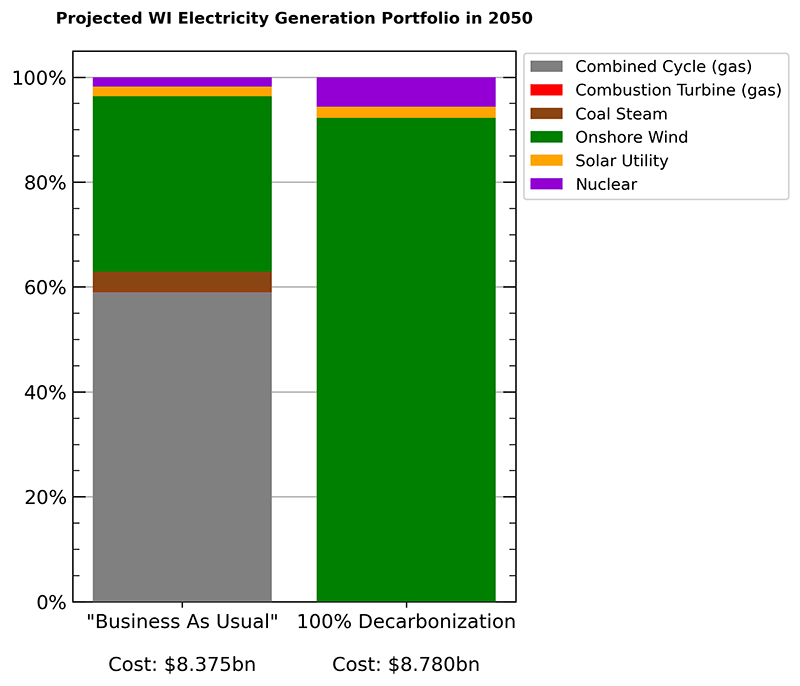Wisconsin has an opportunity to ramp up renewable energy projects to produce electricity in-state while also improving public health. Currently, Wisconsin relies on natural gas and coal to generate electricity. Furthermore, Wisconsin imports these fossil fuels from out of state and spends an estimated $14 billion annually to do so. The burning of fossil fuels emits harmful air pollutants that lead to over 5 million deaths every year globally. Increasing renewable energy can reduce this air pollution and also reduce asthma, cardiovascular disease, and cancer.
In August of 2019, Wisconsin Governor Tony Evers signed an executive order giving Wisconsin a goal to have 100 percent carbon-free electricity by 2050. This executive order gives Wisconsin the second most aggressive plan to decarbonize in the Midwest. Partnering with the UW–Madison Office of Sustainability, our project focused on understanding the cost and technical feasibility of decarbonizing Wisconsin’s electricity system while also quantifying the health benefits of reductions in air pollutant emissions in Wisconsin.
For this research, we utilized two models. The first is WEREWOLF, which forecasts Wisconsin electricity demand for a future year and then constructs an electricity-generation portfolio which meets that demand while achieving the desired percent reduction in carbon emissions. The second model is the U.S. Environmental Protection Agency’s COBRA Health Impacts Screening and Mapping Tool, which estimates the health benefits and associated monetary values of air pollutant emissions reductions. Here we compare two cases for 2050: (1) a “Business as Usual” (BAU) scenario that resembles current carbon emissions trends, and (2) a 100 percent decarbonization scenario.
Our research found that it is technically feasible to decarbonize the electricity grid in Wisconsin by 100 percent, largely by using onshore wind power, and the cost is $8.780 billion (Figure 1). In addition, 100 percent decarbonization of the electricity sector would result in total Wisconsin health benefits estimated at $243 million annually. Health benefits other than reducing mortality can yield an estimated $2.27 million a year. The largest health benefits are the reduction of nonfatal heart attacks and the reduction of days where restricted activity would be necessary for vulnerable people (Figure 2).
In the BAU scenario, which costs $8.375 billion, 65 percent of the electricity demand is still met by fossil fuel sources; however, it is estimated that carbon emissions will still decrease by 19 percent due to a decrease in coal usage relative to current values. In this scenario, the estimated health benefits other than reducing mortality are lower at $0.61 million per year. This research is a starting point in understanding the potential benefits that could be unlocked if Wisconsin decarbonized and produced its electricity in-state, which we show is technically feasible.


Author Affiliations
- Nova Tebbe, UW–Madison Nelson Institute environment and resources doctoral student, ntebbe@wisc.edu
- Jerrold Acdan, UW–Madison Department of Atmospheric and Oceanic Sciences graduate student, acdan@wisc.edu
- Jonathan Patz, UW–Madison Vilas Distinguished Professor and Nelson Institute John P. Holton Endowed Chair of Health and the Environment, Department of Population Health Sciences, patz@wisc.edu
- Michael Ferris, UW–Madison John P. Morgridge Chair in Computer Sciences and Jacques-Louis Lions Professor of Computer Sciences, ferris@cs.wisc.edu